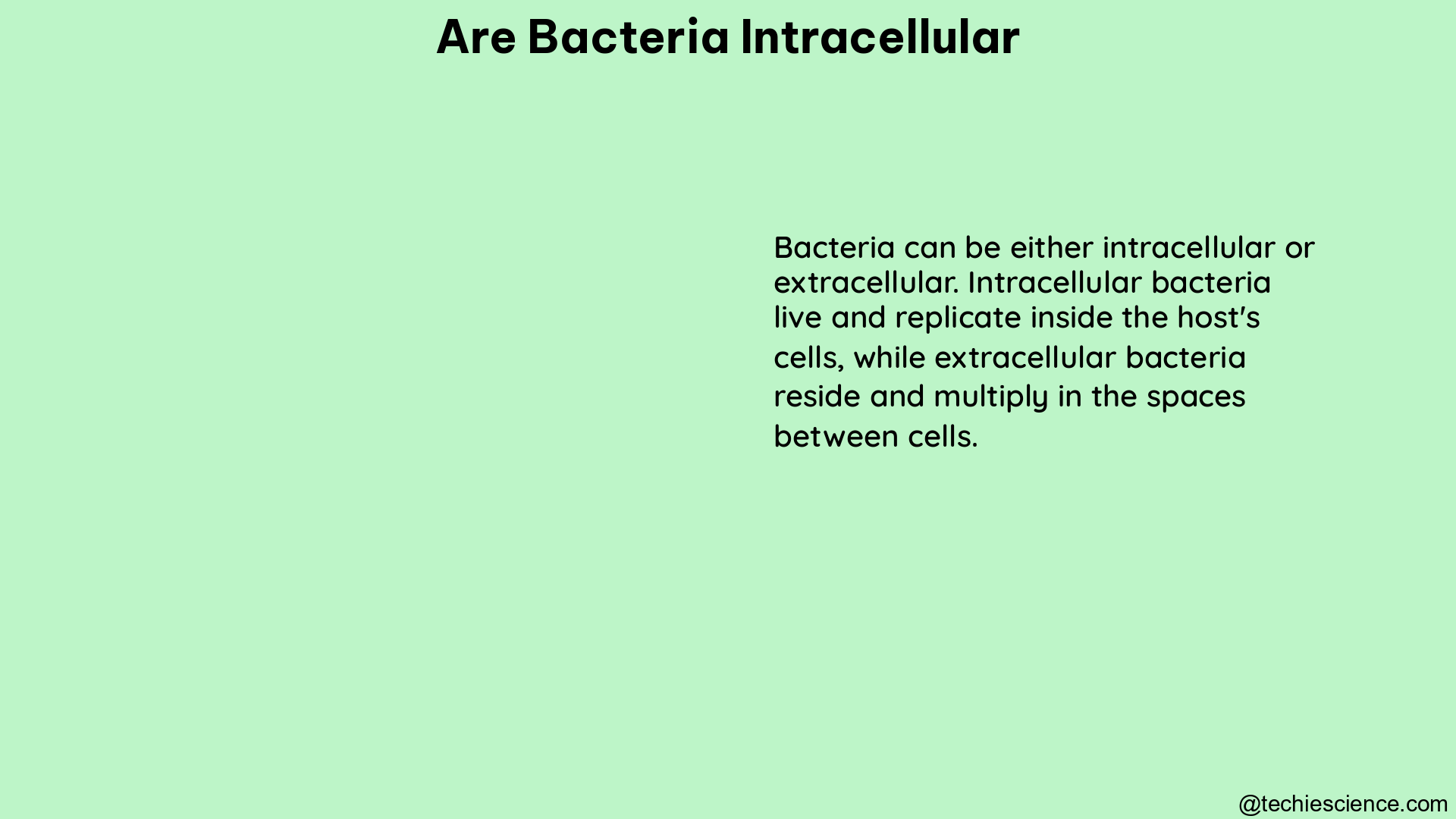Bacteria can be intracellular, meaning they reside and replicate within host cells. This phenomenon is crucial in understanding host-pathogen interactions and the pathogenesis of various bacterial infections. Quantifying bacterial burden within host cells is challenging due to the limitations of traditional methods such as colony-forming unit (CFU) counts, which require time-consuming culturing steps and may underestimate the true bacterial burden.
Understanding Intracellular Bacteria
Intracellular bacteria are a diverse group of microorganisms that have evolved the ability to invade, survive, and replicate within the host’s cells. This lifestyle provides several advantages for the bacteria, including:
- Evasion of Host Immune Responses: By residing within host cells, intracellular bacteria can avoid detection and clearance by the host’s immune system, such as phagocytic cells and antibodies.
- Nutrient-rich Environment: Host cells provide a nutrient-rich environment that supports the growth and replication of intracellular bacteria.
- Dissemination and Transmission: Intracellular bacteria can use the host’s cells as a vehicle for dissemination and transmission to new hosts.
Examples of well-known intracellular bacteria include:
- Mycobacterium tuberculosis: The causative agent of tuberculosis, which can reside and replicate within macrophages.
- Listeria monocytogenes: A foodborne pathogen that can invade and replicate within various host cells, including epithelial cells and macrophages.
- Salmonella enterica: A common cause of foodborne illness, which can survive and replicate within host cells, particularly within macrophages and epithelial cells.
- Chlamydia trachomatis: An obligate intracellular bacterium that infects and replicates within host epithelial cells, causing various diseases such as trachoma and sexually transmitted infections.
Quantifying Intracellular Bacterial Burden

Quantifying the bacterial burden within host cells is crucial for understanding host-pathogen interactions and the pathogenesis of intracellular bacterial infections. Traditional methods, such as colony-forming unit (CFU) counts, have limitations in accurately estimating the true bacterial burden due to the following reasons:
- Time-consuming Culturing Steps: CFU counts require time-consuming culturing steps, which may not accurately represent the actual number of viable bacteria within host cells.
- Underestimation of Bacterial Burden: CFU counts may underestimate the true bacterial burden, as some bacteria may be in a viable but non-culturable state or may be difficult to recover from host cells.
To address these challenges, advanced methods have been developed to estimate the total bacterial volume inside infected cells:
Measuring Bacterial Area on a Z-stack
One method involves measuring the bacterial area directly on a z-stack and using it to calculate estimated partial bacterial volumes. This approach provides a more accurate estimation of the bacterial burden, independent of fluorescence intensities. The workflow for this method is illustrated in Figure 2B of the NCBI article, and the code is available in the “bacterial_burden_volume” notebook in the GitHub repository.
Quantifying Genome Copy Number per Cell
Another study quantified the genome copy number per cell of the obligate intracellular bacterium Orientia tsutsugamushi (Ot) by determining the number of bacterial genome copies in a sample of purified EB and IB Ot using tsa47 qPCR and dividing by the number of bacterial cells in the same sample, as measured by confocal microscopy. This method allows for the relative quantitation of bacterial burden and can be used to monitor the growth or survival of bacteria between different infection conditions.
Live Microscopy of Bacterial Infections
In addition to these quantitative methods, live microscopy of bacterial infections provides valuable insights into bacterial interactions with host cells. For example, using live-cell imaging, the duration of vacuole-like ER interactions around bacteria can be quantified to determine if the ER forms stable interactions with intracellular bacteria.
Advantages of Quantifying Intracellular Bacterial Burden
Accurately quantifying the bacterial burden within host cells offers several advantages:
- Understanding Host-Pathogen Interactions: Quantifying the bacterial burden provides insights into the dynamics of host-pathogen interactions, such as the mechanisms of bacterial invasion, survival, and replication within host cells.
- Monitoring Infection Progression: Tracking the changes in bacterial burden over time can help monitor the progression of intracellular bacterial infections and evaluate the effectiveness of antimicrobial treatments.
- Developing Targeted Interventions: Accurate quantification of intracellular bacterial burden can inform the development of targeted interventions, such as antimicrobial agents or host-directed therapies, to disrupt the intracellular lifestyle of bacteria.
- Improving Diagnostic Accuracy: Quantitative methods can enhance the accuracy of diagnostic tests for intracellular bacterial infections, leading to more effective clinical management.
Conclusion
In summary, bacteria can be intracellular, residing and replicating within host cells. Quantifying the bacterial burden within host cells is crucial for understanding host-pathogen interactions and the pathogenesis of intracellular bacterial infections. Advanced methods, such as measuring bacterial area on a z-stack and quantifying genome copy number per cell, provide more accurate estimations of bacterial burden than traditional CFU counts. Live microscopy of bacterial infections also offers valuable insights into the dynamics of bacterial interactions with host cells. By leveraging these advanced techniques, researchers and clinicians can gain a deeper understanding of intracellular bacterial infections and develop more effective strategies for their prevention and treatment.
References:
- BBQ methods: Streamlined workflows for Bacterial Burden Quantification in Intracellular Infections. https://www.ncbi.nlm.nih.gov/pmc/articles/PMC10592879/
- The obligate intracellular bacterium Orientia tsutsugamushi exists in distinct intracellular and extracellular bacterial populations. https://www.nature.com/articles/s41467-022-31176-9
- An obligate intracellular bacterial pathogen forms a direct interface with the endoplasmic reticulum. https://www.ncbi.nlm.nih.gov/pmc/articles/PMC10274737/
- Intracellular Bacterial Pathogens and Their Lifestyle within Host Cells. https://www.ncbi.nlm.nih.gov/pmc/articles/PMC6152371/
- Quantification of Intracellular Bacterial Burden: Current Challenges and Future Directions. https://www.frontiersin.org/articles/10.3389/fcimb.2020.00193/full
- Intracellular Bacterial Pathogens: From Invasion to Dissemination. https://www.cell.com/trends/microbiology/fulltext/S0966-842X(16)30023-4
Hi..I am Tanu Rapria, I have completed my Master’s in Biotechnology. I always like to explore new areas in the field of Biotechnology.
Apart from this, I like to read, travel and photography.